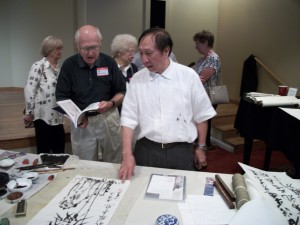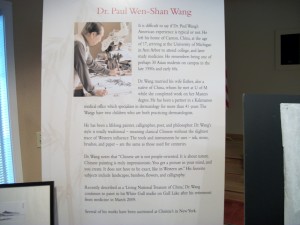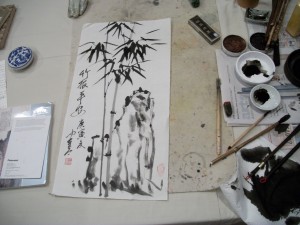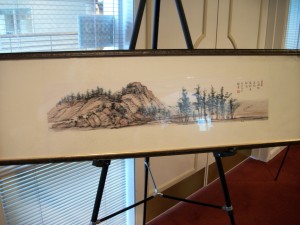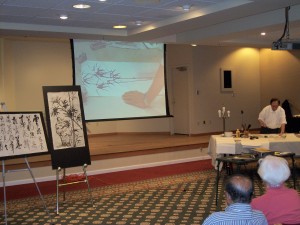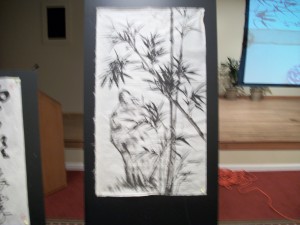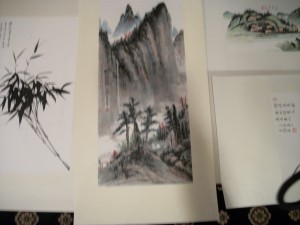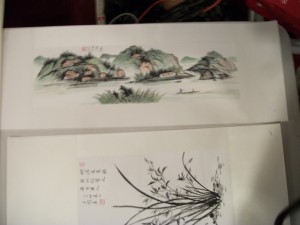This has been a busy week as I am preparing my middle school art classroom for the new school year. Meetings started on Monday and we even had our open house on Wednesday night. It wasn’t a good time to run up to Kalamazoo to check out a Chinese painter and calligrapher. However, since I already have my students work with this material I thought it would be interesting to see the “master” painter, Paul Wang.
Late last week I received an email from the Kalamazoo Institute of Art about the opportunity to go to a demonstration of both Chinese painting and calligraphy. I decided to ask my principal if he would grant me permission to leave early Thursday so I could catch this master painter. Eric did allow me this opportunity, which I am very grateful for as it was refreshing watching a master at work.
The ease in which Mr. Wang painted was obvious, whether he painted Chinese characters or a long, thin bamboo piece. Mr. Wang shared many little stories with his painting techniques. He said this is a dying art. Before the 20th century students had to exhibit their mastery of both painting and calligraphy in an examination. A large portion of the calligraphy is about creating poetry. Students that performed with excellence were brought before the emperor. They would be assured government jobs. Today the young people of China are more interested in technology. Chinese painting and calligraphy are becoming sought after because of the rarity of true masters.
He said Chinese painting is true “impressionistic” painting as the artist studies nature but does not try to recreate it exactly as it is. It is more about capturing the essence of what it is. The strong contrast between the black of the ink and the white of the paper make it possible to see small subtleties of differences much like a black and white photograph. Bamboo would be painted if you are having a bad day. Orchids might be painted if you are having a good day. He talked about bamboo being strong and hollow but also pliable. When painted it should be straight. The bamboo is symbolic of strength. As the shoot grows one can notice a thickening in the shoot and then it is thin again. That thickened area symbolizes courage. The hollow part of the bamboo is to show humbling. If you think of a person this falls in line with what Confucius would say. Much of Chinese painting and calligraphy is tied to the teachings of Confucius. I found all of this so interesting and helpful to me for sharing with my middle school students.
At the end of the demonstration I purchased a catalog of artwork by Mr. Wang and he signed it for me. He explained the difference between artwork on a scroll or for hanging. He sends his work back to China to be mounted. Sometimes it is put on a scroll to read at night. These pieces are usually full of poetry. He said that people who read the scrolls at night sleep well! He also had calligraphy printed up in accordion style books. This was fascinating. He explained how the Chinese characters are symbols for other things. He painted a symbol for a woman and put it with one for a boy. He said that represented “good” because the two together are good.
He asked if we had noticed a difference between the Japanese woodcuts and the Chinese brush painting at the Kalamazoo Institute of Art. He was so funny when he shared with us the fact that the Japanese do self portraits where as the Chinese are more interested in nature and any person depicted would be more of a symbol. He grimaced and made faces for how the Japanese made almost caricatures of people and that too was so fun and very fascinating.
All and all I had a great day! Mr. Wang has been painting for sixty five years. I could sense the peacefulness in his quick, sure strokes and I felt fortunate to have witnessed this special man with his graceful dignity and obvious humble nature. He isn’t just a master painter and calligrapher but he is also a master teacher in the way he shared so many wonderful stories about the art forms and its place in history.
Many of the things he shared today can be read about on his website. It is well worth reading.

